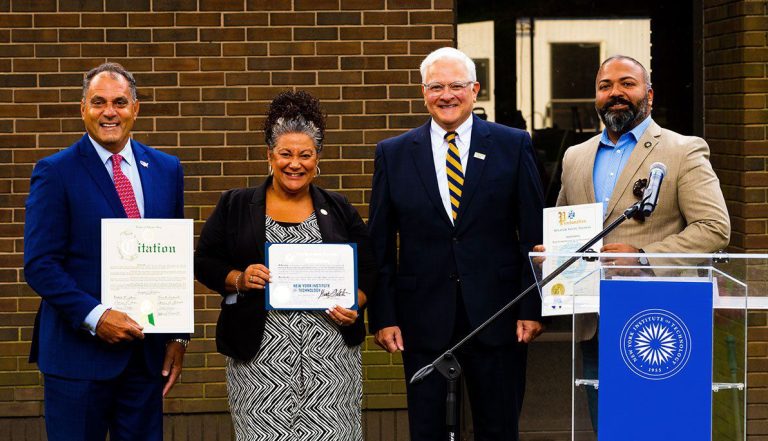
On Sept. 15, members of the New York Institute of Technology community and elected officials gathered on the university’s Old Westbury campus for a ceremony at the site of the former 500 Building to officially kick off the construction of the university’s Biomedical Research, Innovation, and Imaging Center.
The state-of-the-art facility is anticipated to expand the institution’s research footprint and further its strategy to become a Carnegie-classified Research 2 university by 2028.
The project, which is expected to be completed in the first quarter of 2025, will transform the former 500 Building into a reimagined 20,000-square-foot research center with collaborative laboratories and cutting-edge imaging equipment.
In turn, New York Tech faculty and students, as well as researchers from other institutions, will have new opportunities to advance discoveries and potential treatments for pressing health conditions and biomedical challenges, including heart disease, cancer, and Parkinson’s disease, among many others.
“The BRIIC will fill a need for high-resolution microscopy in the Long Island region, thereby creating the opportunity to invite researchers from other institutions to utilize our advanced visualization technologies. At the same time, while the BRIIC will centralize our research instruments, it will also propel New York Tech’s research into the future,” said President Hank Foley.
Serving as New York Tech’s primary microscopy center, the BRIIC will house a multi-color 3D STED (stimulated emission depletion) microscope secured by the College of Osteopathic Medicine with the support of a $1.05 million grant from New York State’s Regional Economic Development Councils.
STED microscopes have a resolution approximately 10 times higher than standard confocal microscopes, providing a more precise view of cell structure.
Given this, they offer greater possibilities to understand how cancers, multiple sclerosis, and other diseases develop. In addition, microscopy equipment currently located in NYITCOM facilities will be relocated to the BRIIC upon its completion.
The new facility will also feature a 2,000-square-foot functional magnetic resonance imaging suite dedicated solely for research purposes.
The fMRI technology will offer a non-invasive solution to map and measure human brain activity, allowing for better analysis of brain abnormalities, cognitive function, and treatment efficacy.
It may also advance studies previously limited to animal models by allowing scientists to observe conditions in human subjects, thereby opening the door for innovative research into Parkinson’s disease, Ehlers-Danlos syndrome, autism spectrum disorder, clinical depression, brain injuries, and other critical conditions.
“Today’s complex, real-world issues cannot be solved by one scientific discipline alone,” said Provost and Executive Vice President Jerry Balentine. “As New York Tech continues to expand its research activities, the BRIIC will provide an interdisciplinary environment in which researchers across various scientific fields, schools, and colleges will sync their technical expertise and creativity to address some of the most vexing biomedical questions.”
In addition to its high-tech imaging equipment, the BRIIC will include a 2,880-square-foot open laboratory space with 48 lab benches designed with flexible infrastructure to accommodate additional researchers, as well as core labs, fume hoods, tissue culture rooms, a freezer room, and an autoclave. The building will also feature study and conference rooms, a postdoc area, and researcher offices.
To date, architecture, design, engineering, and project management firms involved in the project include Buro Happold, DLR Group, Jacobs, Napach Design Group, Sherwood Design Engineers, Turner Construction Company, and Zubatkin Owner Representation.






